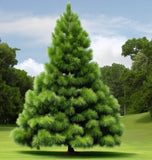Pinus taeda (Loblolly Pine, Frankincense Pine)
Pinus taeda (Loblolly Pine, Frankincense Pine) is a large pine tree species native to the southeastern United States. It is named for its characteristic loblolly, or "low and wet," habitat preference and its resin, which has been historically used as a substitute for frankincense.
Loblolly Pine is a fast-growing evergreen tree that can reach heights of 80 to 100 feet (24 to 30 meters) with a spread of 25 to 35 feet (7 to 11 meters). It has a straight trunk and a conical crown that becomes more irregular with age. The bark is thick, grayish-brown, and deeply furrowed.
The needles of Loblolly Pine are arranged in clusters of three and measure about 6 to 9 inches (15 to 23 centimeters) long. They are dark green and relatively flexible. The tree produces ovoid cones that are around 3 to 6 inches (7 to 15 centimeters) long. The cones have a rough texture and contain small winged seeds.
Loblolly Pine is adapted to a variety of soil conditions and can be found growing in a range of habitats, including low-lying areas, moist bottomlands, and upland forests. It is known for its tolerance to poor drainage and periodic flooding, hence its association with loblolly habitats.
This species plays an important ecological role in its native range. Loblolly Pine forests provide habitat for various wildlife species and contribute to the conservation of biodiversity. The dense foliage and large canopy of the tree provide shade and cover for animals. The tree's seeds are a food source for birds and small mammals.
Loblolly Pine has economic significance as well. Its wood is valued for its strength and is used in construction, utility poles, furniture, and paper production. The tree's fast growth rate and ability to be cultivated in large plantations make it a valuable timber resource.
In addition, Loblolly Pine has been planted for reforestation and land rehabilitation purposes. It is often used in afforestation projects, as windbreaks, and for erosion control due to its rapid growth and ability to stabilize soil.
Overall, Pinus taeda, the Loblolly Pine or Frankincense Pine, is a prominent tree species in the southeastern United States. It is recognized for its fast growth, adaptability to various environments, and its ecological and economic importance.
Botanical Name : Pinus taeda
Common Name : Loblolly Pine, Frankincense Pine
Height : 110 ft
Spread : 25-35 ft
Germination Info : Seed requires 60 days cold moist stratification.
Hardiness zone : 6-9
Average seed per ounce : Approx. 1000
Germination Range: 70-90%


















